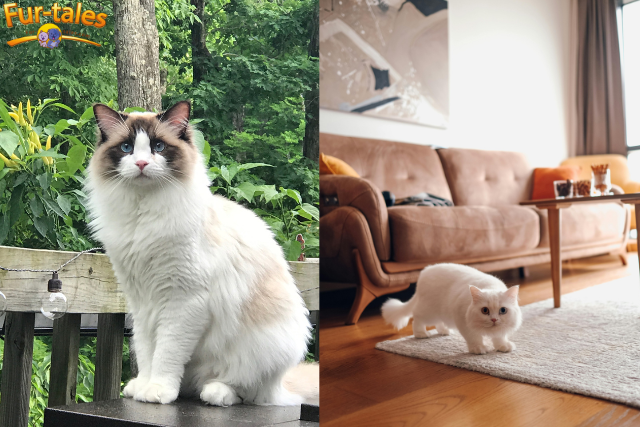
Large vs. Small Cat Breeds: Size and Health Considerations
When it comes to choosing a feline companion, many factors come into play. From personality to coat type, every cat lover has their preferences. However, one often overlooked but important aspect of cat ownership is size. Whether you are drawn to the majestic Maine Coon or the petite Singapura, the size of your cat can affect not only your lifestyle but also the cat’s overall health.
Understanding the differences between large vs. small cat breeds is essential for making informed decisions about care, health, and living arrangements. In this guide, we will explore how size impacts cats, from general temperament and activity levels to common health considerations. Whether you’re already a cat parent or considering adopting a new furry friend, this information will help you provide the best life possible for your chosen breed.
What Defines Large and Small Cat Breeds?
Before diving into health considerations, it helps to understand what makes a cat breed “large” or “small.”
Large cat breeds typically weigh between 13 to 20 pounds or more. Some of the most well-known large breeds include:
Maine Coon
Ragdoll
Norwegian Forest Cat
Savannah
Siberian
Small cat breeds usually weigh between 4 to 9 pounds. Popular small breeds include:
Singapura
Devon Rex
Cornish Rex
Oriental Shorthair
Munchkin
It’s worth noting that individual cats may fall outside these averages, and mixed breeds can vary widely in size.
Personality and Lifestyle Differences
While size doesn’t determine personality, certain trends can be seen among large and small cat breeds.
Large Breeds
Tend to be more laid-back and affectionate
Often called “gentle giants”
Require more space to stretch and play
Generally get along well with children and other pets
Small Breeds
Usually more active and playful
Often described as curious and mischievous
Need less space but more mental stimulation
May prefer climbing and jumping due to their lighter frames
Of course, individual personalities vary, but size can play a subtle role in how your cat interacts with you and their environment.
Health Considerations for Large Cat Breeds
Larger cats are undeniably beautiful and majestic, but their size can come with health risks that owners need to monitor closely.
Joint and Mobility Issues
Large breeds are more prone to joint problems like hip dysplasia and arthritis, especially as they age. Their heavier weight puts additional stress on joints, which can lead to discomfort and mobility challenges later in life.
Heart Conditions
Some large breeds, such as Maine Coons, are genetically predisposed to hypertrophic cardiomyopathy (HCM), a condition where the heart muscle thickens. Routine veterinary check-ups and heart screenings are crucial for early detection and management.
Obesity Risks
Because of their laid-back nature, larger cats can become overweight if not provided with enough exercise and a carefully monitored diet. Extra weight exacerbates joint problems and can lead to diabetes and other issues.
Grooming Needs
Many large breeds have long or dense coats that require regular grooming. If neglected, mats and tangles can become painful and lead to skin infections.
Health Considerations for Small Cat Breeds
Smaller cat breeds come with their own set of health concerns, often related to their delicate frames and high energy levels.
Fragility and Bone Health
Tiny or delicate breeds like the Munchkin are more prone to bone-related issues, including fractures and arthritis in breeds with short legs.
High Metabolism
Smaller breeds generally have faster metabolisms, meaning they need nutrient-dense food to maintain energy levels. Malnutrition can be a risk if dietary needs aren’t properly met.
Dental Problems
Some small cat breeds are predisposed to dental issues due to smaller jaw size and crowded teeth. Regular dental care, including brushing and professional cleanings, is essential.
Temperature Regulation
Tiny cats tend to have less body fat and may get cold more easily, especially in colder climates. Warm bedding and cozy spaces are important for their comfort.
Nutrition and Feeding Tips for Cats of All Sizes
Regardless of breed size, proper nutrition plays a critical role in keeping your cat healthy. However, there are a few considerations based on size.
For Large Cats
Feed portion-controlled meals to prevent obesity
Provide food formulated for large breed cats, when available
Encourage movement with toys and climbing structures
For Small Cats
Choose calorie-rich and nutrient-dense foods to meet high energy demands
Offer frequent, smaller meals if your cat is highly active
Monitor weight and body condition closely
Always consult your veterinarian to create a feeding plan that matches your cat’s breed, age, and lifestyle.
Choosing the Right Cat for Your Lifestyle
When deciding between large and small cat breeds, consider your living environment, household members, and lifestyle.
Choose a large breed if:
You have ample space for climbing and playing
You prefer a calm, gentle cat
You are committed to regular grooming (if the breed has long fur)
Choose a small breed if:
You live in an apartment or smaller home
You enjoy interactive play and high-energy activities
You want a cat that can easily travel or move around compact spaces
Ultimately, every cat is unique, and breed size is just one of many factors to consider. Always spend time with a cat before adoption to ensure their personality fits your expectations.
FAQs About Large vs. Small Cat Breeds
Q1: Do large cat breeds live shorter lives?
Not necessarily. While some large breeds are prone to specific health issues, proper care and regular veterinary checkups can help them live long, healthy lives.
Q2: Are small cats healthier than large cats?
Not always. Both large and small breeds face unique health challenges. The key is tailored care based on your cat’s specific needs.
Q3: Can large and small cats live together peacefully?
Yes. With proper introductions, cats of all sizes can coexist harmoniously. Individual temperament matters more than size.
Q4: Do larger cats require more food than smaller cats?
Typically, yes. Larger bodies burn more calories at rest, but feeding should always be based on individual needs and vet recommendations.
Q5: Which size is easier to care for?
It depends on your lifestyle. Smaller cats may be easier in small spaces, while larger cats are often calmer and require less intensive playtime.
Image Designed Using Canva
